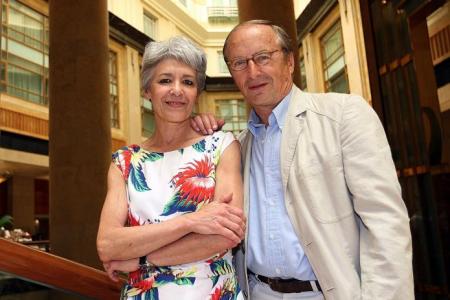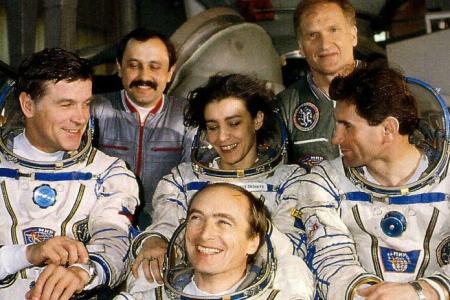French couple went on space missions
The Haignerés are a rare husband-and-wife pair of astronauts who have been to space on separate missions
They may look like your ordinary down-to-earth French couple. But Brigadier General Jean-Pierre Haigneré and Dr Claudie Haigneré have shared out-of-this-world experiences.
The two former European Space Agency astronauts are among the rare husband-and-wife pairs who have been to space, not once but twice each.
They even have an asteroid, 135268 Haigneré, named after them.
General Haigneré, 67, and Dr Haigneré, 58, were in Singapore yesterday to give a talk on space exploration and research as part of Voilah! 2015, a festival that celebrates Singapore's 50 years of diplomatic relations with France.
They first met in 1985 when they were among the seven selected out of 1,000 candidates in a search for astronauts by the French National Space Agency.
But the couple did not get to share any space missions. Dr Haigneré was a back-up crew member for her husband, who went on space missions in 1993 and 1999. She finally made it to space in 1996, spending 15 days in the Russian Mir space station, as France's first woman astronaut.
In 2001, Dr Haigneré also became the first European woman to visit the International Space Station (ISS), where she stayed for eight days conducting scientific experiments.
"I did not feel different as a woman on the crew, because we were so success-oriented and such a diverse team. But when I came back, I realised that the experience set me apart," she said.
INSPIRED
Dr Haigneré said that as a 12-year-old girl, she was inspired by Neil Armstrong, the first person to land on the moon in July 1969.
"I read a lot of science fiction after that, because from this event I witnessed how a dream became reality," she said.
She studied medicine and was working as a doctor when she was selected for the opportunity to train at Star City, Russia's cosmonaut training centre near Moscow.
There she met and fell in love with fellow trainee and test pilot Haigneré, who came from an engineering background in the French Air Force.
The space training was tough, and the crew also had to learn Russian since it was a Russian flight.
"There were lots of technical things to master, but Russian was the most difficult," she said.
There were other challenges for the couple, especially in 1999, when General Haigneré went on the six-month Perseus mission on Mir station and could only occasionally talk to his wife at Star City.
"It was frustrating becomes sometimes I could get through to her, but we could not understand each other because the line was fading. I would not be able to talk to her for weeks at a time," said General Haigneré.
SPACE WALK
There were also amazing highlights. For example, while conducting biological and comet dust experiments in 1999, he had the chance to space walk.
"It was a pleasant sense of freedom, one of those special moments that impacts the rest your life," he said.
He said that adjusting back to normal life on earth was the hardest part of his career as an astronaut.
Although General Haigneré has published three books since 2006 containing photographs that he took in space, he could not bear to look at the photos until two years after his last space mission.
"After seeing such extraordinary things in space and doing significant scientific research, you start to feel like you are not important any more when you return," he said.
Dr Haigneré, on the other hand, said that she did not even have time to think about adjusting back to life on earth.
"I was immediately given a job by the government as minister of research and new technologies and I took up the new opportunity," she said.
These days, the couple are happy to talk to young people about their adventures in space.
"So few have been in space and we have the privilege to be able to explain this perspective. Being in space is more exciting, more beautiful than I could have ever imagined," said Dr Haigneré.
It was a pleasant sense of freedom, one of those special moments that impacts the rest your life.
- Brigadier General Jean-Pierre Haigneré on his space walk
'YOUNG LACK INTEREST IN SPACE TECHNOLOGY'
While space exploration in the 1960s ignited their interest in science when they were young, the Haignerés lamented that it is difficult to get the young people of today excited about space technology.
"Not many young people we speak to are interested. They are more into other types of technology," mused General Haigneré as he pointed at this reporter's mobile phone.
They presented a talk at the Singapore Science Centre yesterday on their experiences in space and the technology behind space exploration, to an audience of about 250 students and guests.
The couple, who hope to inspire young people about space exploration, worry that in a world where space and virtual reality is accessible via realistic movies and video games, youth do not see the point of going through the rigorous training of astronauts.
"Space is about the exploration of what is beyond the horizon, and going further than you have gone before. Without exploration there can be no creation," said General Haigneré.
They have carried out experiments on the effects of weightlessness on the body while in space, and believe that space exploration pushes the boundaries of scientific research.
For those scared of the risks of going to space, General Haigneré said that there should be no fears.
"It is a job that you have trained so many hours for, like a surgeon would not be frightened about carrying out operations," he said.
Dr Claudie Haigneré said: "With intelligence and technology, nothing is impossible. We represent the reality of what happens when young people are patient enough to make their dreams come true."
Get The New Paper on your phone with the free TNP app. Download from the Apple App Store or Google Play Store now



